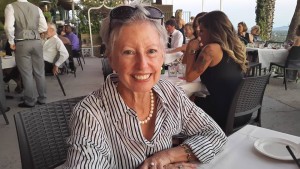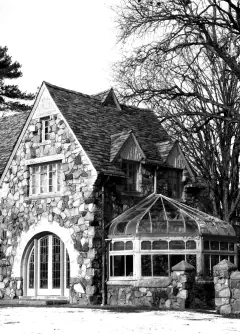By Teddy Robertson
We sit in a rectangle of tables, old manila file folders halved and then creased so we can write our names and prop them up in front of us.

Teddy Robertson
I’ve found my way to the basement of the Unitarian Universalist church for the meeting of a group called Communication/Publication. It’s something to do with water and print media.
Jan [Worth-Nelson, EVM editor] has asked me to find out what’s going on. Is there a role for East Village Magazine here?
I am clueless, but diligent. Ready for an hour and a half meeting on a cold Monday afternoon in late March.
Around the table are some 25 people from non-profits, grass-roots organizations, churches; many greet each other and chat—it’s clear that they’ve been working together for some time.
Jamie-Lee Venable, tall and strong-voiced, in a Live United tee shirt convenes what I now understand is the Communication Workgroup, one of six workgroups that together form Flint Water Crisis Community Partners. All around the table people introduce themselves, say whether they represent an organization. In fact, just being a Flint resident or concerned citizen suffices—-the group is open to all. Every meeting begins this way, I learn later. Every meeting someone new comes.
I’ve styled myself as an observer from East Village Magazine, glad to seem useful. And I live in Flint.
Scanning the manila cards scrawled with first names and organizations, I decipher the initials: EPA, HHS, ARC/LWV, and AARP are clear to me. Some I am learning: CBOP (Community Based Organization Partners) and CAC (Communication Access Center)—services for the Deaf. Two signers are here.
Present too are Salvation Army, Genesee County Health Department, Michigan Works, the Genesee County Medical Society, Save the Children (they target the over 5000 children not in Head Start), Valley Area Agency on Aging, and two uniformed National Guard officers—presumably from the Mayor’s office. They listen, sometimes answer questions.
The Unitarian minister, Deane, contributes her pastoral insight and experience with clergy who advocate for the people of Flint.
A few people strike me as old hands at community organizing: Joe King from Flint Neighborhoods United, Jane Richardson from Salem Housing and the paper, Flint Our Community Our Voice, and Jane O’Dell from the Flint’s Community Resolution Center.
A regional organization, Crossing Water, is here in the person of Michael Hood, acerbic and outspoken. Devoted to disaster relief for vulnerable communities, Crossing Water coordinates with social services and mobilizes teams of volunteers who go house to house, install, fix or change filters. Check if young children (under six years) or pregnant or nursing mothers are in the home. The reports from the front is discouraging.
But after a winter of blaming and castigation, suspicion and aspersion, MSNBC exposés, presidential candidate slogans, and Congressional hearings, I am cheered to sit in a group where local staff from EPA, Health and Human Services, and the Genesee County Health Department respond supportively to questions, text queries to their superiors, and take notes to get more information from their offices.
And it’s clear from the discussion that answers do come back. These folks see one another every Monday; they evince the ease of people going at a common problem for a couple of months together.
As a veteran of decades of academic committees, I can see the picture emerging. First order of business is a review of “open issues.” Who has answers for the list from last time?
The Communication group works steadily through questions about organ and blood donation (various reasons why lead transmission through blood transfusions would be low; organs also low since majority of lead is stored in blood and bone rather than organs), the effect of heat on plastic water bottles (EPA doesn’t anticipate problems since the kind of plastic is stable), getting a flow chart that shows the official entities involved in Flint water recovery efforts (Jaime-Lea is getting this; word is that a unified document is in the works but will take months). The community needs a single source of information; this is a traumatized population.
Discussion moves to today’s concerns. First voice at the table comes from the Genesee County Medical Society about problems with calling 2-1-1 to report skin rash issues and get to free screening with dermatologists; why is there a 40-60% no show rate?
The deaf community representative notes that those using the “relay” ID complain that they are often denied service (a problem in general with doctors). Someone mentions that a lead screening program was also put in place right away and it’s not being used.
Then there’s the media and conflicting information. Water Defense (Mark Ruffalo’s group) hasn’t shared their data on why not to bathe in the water with EPA. The EPA stance remains the same: except for young children bathing is okay. Both EPA and CDC continue to test.
What about people with pacemakers and metal implants? It goes on the list.
Back to the media and how to hold them responsible for accuracy? Corrections after the fact are useless. What about a press conference with media? (This is voted down). Sometimes the headline is inflammatory while the whole article body not. Local radio does the same. Media expand the context of misinformation while the real news is that there is conflicting information.
Then there’s the issue of uniformed National Guard at the points of distribution for water—the PODs. Some populations (such as the undocumented) are wary of uniformed presence. Fire stations are phasing out in favor of community PODs, C-Pods, one in every ward in the city. More education—verbal information and flyers— can take place at C-PODS.
I check the time; the hour and a half is nearly up and the group has not yet broken out into its two task groups to work on the website and print publication. The issues that have come forth today have swamped the meeting.
Although it’s too late to work today, the two task groups report: website people have made progress and a shell is ready. It’s a measure of our computerized society that the website seems an easier task than the print challenge—up-to-date material in simple language for a range of different groups unlikely to use the internet (senior citizens, homebound, illiterate, vision impaired, homeless, undocumented, and non-English speaking are some of the 19 categories).
The print people also have a list of 50 trusted sources to communicate print information. How to cover printing costs, especially high because color graphics are needed. EPA has produced an effective flyer with simple language and graphics, but it bears the EPA logo. So the next question is who are the people whom will these populations trust? Who are the individuals and organizations who can get reliable information to people on the other side of the digital divide, mistrustful, wary of endless conflicting information, worn down by changing conditions?
I am a print person, happy to find myself among those struggling with paper and text and distribution. It’s five p.m. and people are packing up. The publications task group is frustrated. They assure me that today’s meeting was an exception; next Monday the break-out into the two groups will happen first.
For me, for now, I take home what one participant leaned over to me and said as today’s session ended, “you come to one meeting and you are no longer observer; it is your meeting now.”
Note:
This was the first of a series of meetings of the Communication Workgroup of Community Partners that Teddy Robertson attended on March 21, 2016. She has continued to attend their Monday meetings. The website has now been launched; find it at http://flintcares.com The publications task group has developed a print flyer using simple language and graphics called “The Bottom Line.” Information comes from the website where accuracy is vetted; content of “The Bottom Line” will change according to current need. First issue deals water resource sites and using and changing home filters. Next issues will deal with nutrition and Legionella.
EVM columnist Teddy Robertson can be reached at teddyrob@umflint.edu.


You must be logged in to post a comment.